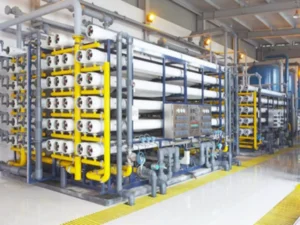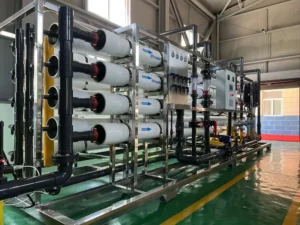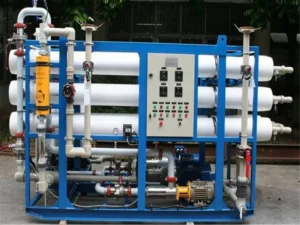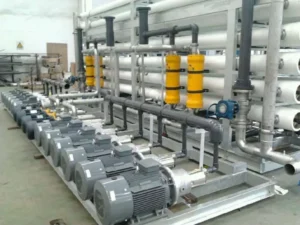Seawater reverse osmosis desalination system-50m3pd
Seawater Reverse Osmosis (SWRO) system is a water purification technology that uses pressure and semipermeable membranes to remove salt, minerals, and impurities from seawater, producing freshwater. It is the most widely adopted method for large-scale seawater desalination globally, addressing critical water scarcity issues in coastal regions.
How SWRO Works?
Pressure Application:
Seawater is pressurized (typically 60–80 bar) using high-pressure pumps to overcome the natural osmotic pressure, forcing water molecules through the membrane while rejecting dissolved salts and contaminants.
Membrane Filtration:
The reverse osmosis membrane acts as an ultra-fine filter (pore size <0.0001 microns), allowing only water molecules to pass through. Salt ions, bacteria, viruses, and organic matter are trapped and flushed away as concentrated brine.
Product Water:
The permeate (freshwater) is collected, while the brine (high-salinity waste) is discharged or treated further.
————————————————————————————————————————————————————
1. Design scope for this system.
1) Input water: Seawater, set TDS=40,000ppm
2) Output water: TDS less than 500ppm
3) Water temperature: 2—50℃
4) Production capacity: 50m3PD
5) Voltage: 380V/50Hz, 3 phase
6) Power supply: Single unit power need 300KW X2 units
7) Delivery: 40ft High Container×4 pcs
———————————————————————————————————————————————————–


————————————————————————————————————————————————————
seawater reverse osmosis system Feature:
– High Efficiency: Removes >99% of salts and most contaminants.
– Scalability: Suitable for small portable units to mega-scale plants (producing millions of gallons daily).
– Energy Efficiency: Lower energy use compared to thermal desalination methods (e.g., multi-stage flash distillation).
– Environmental Impact: Reduced carbon footprint when paired with renewable energy.
Applications
– Municipal Water Supply: Providing drinking water in arid regions (e.g., Middle East, California).
– Industrial Use: Cooling water for power plants, process water for manufacturing.
– Maritime: Onboard freshwater production for ships, offshore platforms, and islands.
– Emergency Relief: Portable SWRO units for disaster zones.
Process flow
Source water storage (By client): Feed pump—prechlorine—-multimedia filter—10 micron filter —acid dosing—SMBS dosing—Antisclant dosing—–5 micron filter—-SWRO with CIP and stop flush device.
| Process Step | Core Function |
| Source Water Storage | Stores raw seawater and stabilizes feed flow to the system |
| Feed Pump | Provides inlet pressure (0.3-0.5 MPa) to overcome system resistance |
| Prechlorination | Oxidizes organic matter, inactivates microorganisms, and reduces SDI (<5) |
| Multimedia Filter | Removes suspended solids (50-100μm) and reduces turbidity to <1 NTU |
| 10 Micron Filter | Intercepts fine particles from multimedia filtration |
| Acid Dosing | Adjusts pH to 6.5-6.8 for optimal antiscalant performance |
| SMBS Dosing | Neutralizes residual chlorine (Cl₂ + NaHSO₃ → HCl + NaHSO₄) to protect RO membranes |
| Antiscalant Dosing | Sequesters calcium/magnesium ions and inhibits carbonate/sulfate scaling |
| 5 Micron Filter | Ensures SDI <3 entering RO membranes and intercepts colloidal substances |
| SWRO System | Desalinates via RO (salt rejection >99.5%) with product water conductivity <500 μS/cm |
| CIP & Stop Flush | Chemical cleaning (citric acid/NaOH circulation) and freshwater flush during shutdown |
———————————————————————————————————————————————————-
seawater reverse osmosis system:
2. Control method of seawater reverse osmosis system
Whole system use PLC (Brand: Siemens HMI) Full/semi automatically control models, both model can be exchanged accordingly.the RO system will be flushed automatically at each startup and shutdown.
High water level auto stop, low water level auto start. Pump is protected when there is no water, no power, poor power, larger electrical current, leakage or short circuit, then it will output the alarm signal. System adopt turbocharge systems can save the electrical power consumption.
CIP(Cleaning In Place) function can help protect the membrane to extend the service life of it.
20m3/D seawater desaliantion plant 45m3pd seawater desalination plant


——————————————————————————————————————————————————
Click here : Seawater reverse osmosis system detail list contact us.
Click here: Watch more product video introductions.
——————————————————————————————————————————————————
Inquiry seawater reverse osmosis system guides:
To find the most appropriate system/machine/plant for your use, please advise the following information ready
· Product water flow rate ( m3/hr, m3/day, Liter/hr,GPM,GPD etc.)
·Product water purpose(drinking, irrigation, industry process or others)
· Feed Water TDS (Total dissolved solids). Is it from Borehole/salt/brackish/lake water
· TSS(Total Suspended Solid)
· SDI(Silting Density Index)< 3
·· Power (110/220/380V/415V/460V, 50 or 60 Hz) 3 phase.
· It is necessary to make water analysis reprot for borehole water,lake water, seawater.
· If soure water is tap water no need end to us TDS or water analysis report.
Send your Inquiry Details in the Below, Click “Send” Now!
Quickly discuss and reply you. My ωhaτsαpp +86 18825874379 & haiyuan@swroplant.com
